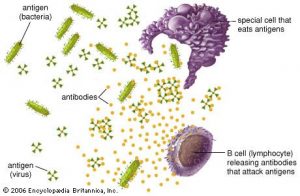What is an antigen?
In general, antigens are composed of proteins, peptides, and polysaccharides. Any portion of bacteria or viruses, such as surface protein, coat, capsule, toxins, and cell wall, can serve as an antigen. Furthermore, a combination of lipids or nucleic acids with proteins or polysaccharides can form more complex antigens, such as lipopolysaccharides.
Lipopolysaccharides are the main ingredients of endotoxins produced by gram-negative bacteria. An antigen contains distinct sites on its surface, called an epitope or antigenic determinant. Antibodies raised against an antigen recognize and interact with specific epitopes through antigen-binding sites (paratopes) to trigger immune responses.
What are the types of antigens?
Antigens are classified primarily based on their origins. For example, antigens that enter the body from outside through ingestion, inhalation, or injection are called exogenous antigens. These include pathogens, chemicals, toxins, allergens, pollens, etc.
Autoantigens or autoantigens are normal cellular proteins or a complex of proteins that are mistakenly attacked by the immune system, leading to autoimmune diseases. A normal self protein becomes a self-antigen due to impaired immunological tolerance, which can be caused by genetic or environmental factors.
Tumour antigens are produced due to tumour-specific mutations that occur during the neoplastic transformation of normal cells into cancer cells. These antigens are expressed on the surface of cancer cells to be recognized by the immune system. However, despite expressing cell surface antigens, most cancer cells acquire the ability to escape immune-mediated clearance.
What are haptens?
Haptens are small molecules that can trigger an immune response only when combined with a carrier protein. The hapten-carrier protein complex is called an adduct. Urushiol, an allergen from poison ivy, is an example of a hapten that causes contact dermatitis. After entering the body through the skin, urushiol is oxidized to produce quinone, a reactive molecule. The quinone then binds to skin protein to form hapten adducts that trigger immune responses.

How do antigens trigger an immune response?
The specificity of the immune response depends on the epitope-paratope interaction. An epitope can be of two types: conformational (discontinuous amino acid sequence of the antigen) and linear epitopes (continuous amino acid sequence of the antigen).
Upon entering the body, an antigen activates the adaptive immune system that comprises specialized immune cells, such as B and T lymphocytes (B cells and T cells). There are two types of adaptive immune responses: antibody-mediated and cell-mediated immune responses. Antibody-mediated immunity is activated when antibodies expressed on the surface of B cells recognize specific epitopes of an antigen and subsequently internalize the antigen.
The antigen is then presented on the surface of the B cell to be recognized by helper T cells, which subsequently activate the B cell. Activated B cells divide rapidly to produce two types of cells: 1) plasma cells that produce antibodies antigen-specific and 2) memory B cells that store antigen-specific information for future protection.
In the cell-mediated immune system, antigen-presenting cells such as dendritic cells, macrophages, and B cells internalize and digest antigen and subsequently present the antigenic fragments on their cell surface through the major histocompatibility complex (MHC). There are two types of MHC molecules: MHC class I molecules (present antigens to cytotoxic T cells) and MHC class II molecules (present antigens to helper T cells). MHC-associated antigenic fragments are presented to T cells by two different pathways.
In the endogenous pathway, MHC class I molecules present endogenous antigens that are derived from pathogen-specific proteins produced within infected cells. However, in the exogenous pathway, MHC class II molecules present antigenic fragments that are derived from extracellular pathogens.
Upon recognizing the MHC-antigen complex, T cells begin to secrete cytokines, which in turn facilitate T cell maturation. T cells that mature into helper T cells produce more cytokines to further attract and activate T cells. macrophages, lymphocytes and neutrophils. T cells that mature into cytotoxic T cells attack and destroy cells infected by pathogens.
Antigens in medical science
Pathogen-specific antigens can be used as diagnostic markers to detect the current infection status of an individual. Rapid antigen tests are immunoassays used to detect the presence of pathogen-specific proteins in biological samples.
Furthermore, pathogen-specific antigens are used in the production of vaccines. During vaccine production, pathogen-specific antigens are processed so that they can induce desired immune responses without causing disease. In tumour vaccines, tumour-specific antigens are used to activate immune cells that specifically attack and kill cancer cells.